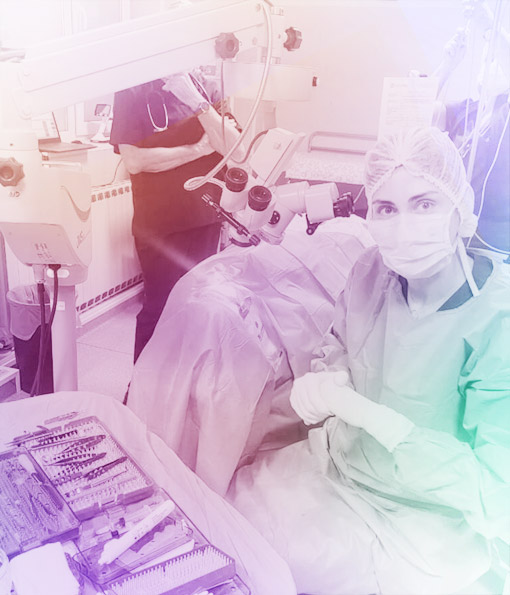Pediatric glaucoma is a rare condition with a major impact on a child’s vision. Elevated intraocular pressure can irreversibly damage the optic nerve, and the difference between a good and an unpredictable outcome is most often made by early diagnosis and an age-appropriate treatment plan. At OFTAPRO, pediatric glaucoma care is built around three simple ideas: accurate evaluation, timely intervention, and long-term follow-up in a child-friendly environment.
When should you suspect glaucoma in a child?
In very young children, signs can be subtle or, on the contrary, quite obvious. Parents often bring their child to the doctor for photophobia (light sensitivity), persistent tearing, and blepharospasm (involuntary eyelid spasms). In infants, elevated pressure may lead to a visibly enlarged eye and an increase in corneal diameter (buphthalmos). Later on, visual disturbances, eye pain, or headaches may occur. These signs alone do not establish a diagnosis of pediatric glaucoma, but they are strong reasons to seek a comprehensive ophthalmologic examination.
What the evaluation includes at OFTAPRO
The consultation is tailored to the child’s age and cooperation level. We begin with the medical history (symptoms, timeline, associated conditions), then proceed through the objective steps:
- Intraocular pressure measurement (tonometry) using age-appropriate methods;
- Assessment of corneal clarity, corneal diameter, and corneal thickness (pachymetry);
- Gonioscopy (examination of the anterior chamber angle), sometimes under general anesthesia in very young children;
- Axial length measurement of the eye;
- Dilated fundus examination to evaluate the optic nerve.
- Additional imaging/functional tests, where indicated.
The goal is not only to confirm the diagnosis but to understand the mechanism (e.g., an angle development anomaly in congenital forms) and the severity, so we can recommend the most suitable therapeutic strategy.
Types of pediatric glaucoma – why words matter
Under the umbrella term “pediatric glaucoma” fall several clinical entities: primary congenital glaucoma (from birth), infantile glaucoma (first two years), and juvenile glaucoma (after preschool age). Each comes with distinct diagnostic and treatment specifics. For example, in congenital glaucoma, the therapeutic target is most often to restore the eye’s natural drainage pathway from the outset, while in some juvenile forms, one may begin with medication (if effective), with surgery considered later.
Treatment options: drops, laser, and surgery on the drainage pathway
Treatment is individualized. Antiglaucoma eye drops can lower pressure and are useful as a bridge or adjunct. In congenital and infantile forms, however, the standard of care is surgical, precisely to re-establish the physiologic outflow of aqueous humor. Depending on age, corneal transparency, and angle anatomy, we recommend:
- Goniotomy (when the cornea is clear);
- Ab-externo trabeculotomy (including a circumferential approach where appropriate);
- Selected minimally invasive glaucoma surgeries (MIGS) such as GATT (gonioscopy-assisted transluminal trabeculotomy), in cases where anatomy permits and the indication is clear.
The aim of all these procedures is the same: to lower intraocular pressure by rehabilitating the natural drainage pathway, thereby protecting the optic nerve. Afterward, we follow the child at set intervals and adjust medication if needed.
Why OFTAPRO for pediatric glaucoma
At OFTAPRO, we’ve built an integrated care pathway for children and families: from consultation to intervention and then to long-term follow-up. Our team includes physicians with a strong focus on pediatric conditions; among them, Dr. Lidia Ladea-Degeratu, with experience in anterior segment surgery and ongoing training in childhood glaucoma. Recently, our clinic has introduced minimally invasive techniques for suitable cases, including GATT, strengthening a modern therapeutic portfolio. We work closely across specialties so that every child’s journey remains coherent: investigations, surgical indication (when necessary), visual rehabilitation (glasses, amblyopia therapy), and continuous feedback for parents.
Another advantage is our child-adapted setup: a welcoming environment, instruments appropriate for very young ages, and preparation protocols for consultations/procedures explained in family-friendly language. When examination under anesthesia is required, we collaborate with anesthesiologists experienced in pediatric care. And when the child needs additional support (e.g., optical correction), integration with the rest of the clinic’s ophthalmology services streamlines the process and reduces stress.
How the procedure works (briefly) and what follows
Depending on the technique, the surgeon approaches the drainage angle from inside the eye (ab-interno) or from the outside (ab-externo), using small incisions and dedicated instruments. Procedures are generally short but require a team prepared for pediatric specifics. At discharge, parents receive a clear aftercare protocol: drops/ointments for inflammation and eye protection, guidance on physical activity, hygiene, and sleep. Follow-up visits are scheduled for intraocular pressure monitoring, optic nerve reassessment, and treatment adjustments.
Important: After surgery, many children need glasses and sometimes amblyopia therapy (visual training/occlusion) to reach their best visual potential. Every case progresses at its own pace, but experience shows that keeping to the follow-up schedule and promptly reporting new symptoms helps maintain stable outcomes over time.
Schedule an evaluation
If your child has been diagnosed with pediatric glaucoma or shows concerning symptoms, we welcome you for a consultation at OFTAPRO. We will carry out a complete evaluation, discuss all treatment options, from medication to procedures such as goniotomy, trabeculotomy, or, in selected cases, minimally invasive techniques, and create a follow-up plan tailored to your child.

